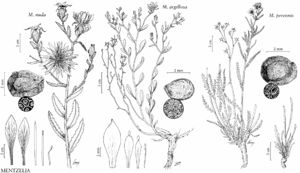Loasaceae
Herbs, subshrubs, shrubs, [or trees], annual, biennial, or perennial, evergreen (leaves withering in age), scabrid, trichomes (1) unbranched and smooth, knobby, notched, or antrorsely or retrorsely barbed, (2) dendritic, and/or (3) stinging. Leaves alternate [opposite], simple; stipules absent; petiole present or absent; blade sometimes lobed, margins entire, serrate, dentate, or crenate; venation pinnate, basal secondary veins commonly present. Inflorescences terminal, cymes, thyrses, racemes, panicles, or flowers solitary. Flowers bisexual, usually radially symmetric, rarely bilaterally symmetric (by bilateral symmetry of corolla, androecium, or gynoecium); perianth and androecium epigynous; hypanthium adnate to ovary proximally and free distally, or completely adnate to ovary; sepals 5, radially symmetric, distinct or connate basally; petals 5, radially or bilaterally symmetric, distinct or connate, sometimes postgenitally coherent; nectary absent or present, distal on ovary; stamens 5–150+, distinct, free or adnate to petal bases, bilaterally or radially symmetric; anthers dehiscing by longitudinal slits; staminodes absent or present, sometimes petaloid and petals appearing to be 6+; pistil 1, 3–7-carpellate, ovary inferior, 1-locular, placentation parietal, subapical, or apical; ovules 1–60+ per locule, anatropous (epitropous); style 1; stigma 1, 2–5(–7)-lobed (lobes usually as many as carpels, except in pseudomonomerous Gronovioideae). Fruits capsules, dehiscence by apical valves [splitting longitudinally], or cypselae, sepals or sepals and petals persisting. Seeds 1–60+ per fruit.
Distribution
North America, Mexico, Central America, South America, sw Asia (w Arabian Peninsula), Africa, Atlantic Islands (Cape Verde), Pacific Islands.
Discussion
Genera 20, species ca. 350 (4 genera, 94 species in the flora).
Loasaceae are in Cornales and are the sister family of Hydrangeaceae. The two families likely diverged in western North America or Mexico in the Late Cretaceous to Paleocene, 92–58 million years before present (J. J. Schenk and L. Hufford 2010). Most extant species of Loasaceae in western North America date to the Oligocene or more recent times, with the Miocene and later periods being especially rich phases for speciation (Schenk and Hufford; J. Grissom and Hufford, unpubl.). In Loasaceae, Eucnide and Schismocarpus S. F. Blake, a genus restricted to southern Mexico, are the earliest diverging lineages, and the cliff-dwelling habits of these two genera may be plesiomorphic for the family (Hufford et al. 2003). The species-rich genus Mentzelia is well supported as the sister of a clade that consists of the taxonomically depauperate genera Cevallia, Fuertesia Urban, Gronovia Linnaeus, and Petalonyx. Phylogenetic studies support the monophyly of subfamilies Gronovioideae Fenzl and Loasoideae Gilg as conceived by I. Urban and E. Gilg (1900), but their early concept of Mentzelioideae as including both Eucnide and Mentzelia (and also Schismocarpus according to S. F. Blake 1918b; Gilg 1925b) is paraphyletic (Hufford et al.). To enable classification based on monophyly, circumscription of Mentzelioideae should be restricted to Mentzelia. The Mentzelia plus Gronovioideae clade is sister to the more taxon rich subfam. Loasoideae, which is especially prevalent in Andean South America (Hufford et al.).
Selected References
Illustrations
Key
| 1 | Stamens 5; seeds 1 per fruit; fruits cypselae. | > 2 |
| 2 | Inflorescences headlike thyrses, peduncles to 1 dm; perianth whorls similar, sepals and petals white to yellowish abaxially, yellow adaxially, linear-lanceolate; petals densely hairy on both surfaces; stamen filaments dorsiventrally flattened, linear, shorter than anthers; anthers with distal connective extension; stigmas densely hairy. | Cevallia |
| 2 | Inflorescences racemes or panicles, peduncles inconspicuous; perianth whorls differentiated, sepals green, lanceolate, petals white, spatulate; petals glabrous except hairy abaxially on midribs; stamen filaments filiform, longer than anthers; anthers without distal connective extension; stigmas papillate. | Petalonyx |
| 1 | Stamens 8–50+; seeds (1–)2–60+ per fruit; fruits capsules. | > 3 |
| 3 | Pistils 3-carpellate; stigmas 3-lobed. | Mentzelia |
| 3 | Pistils 5–7-carpellate; stigmas 5–7-lobed. | > 4 |
| 4 | Hypanthium completely adnate to ovary; petals connate proximally to 1/2+ length; stamen filaments filiform; pedicels elongating in fruit; seeds cylindric to ovoid, to 1 mm, not winged. | Eucnide |
| 4 | Hypanthium adnate to ovary proximally, free distally; petals distinct or connate basally; 5 outermost stamen filaments dorsiventrally flattened, spatulate; pedicels not elongating in fruit; seeds dorsiventrally flattened, 2.3–4 mm, winged. | Mentzelia |


